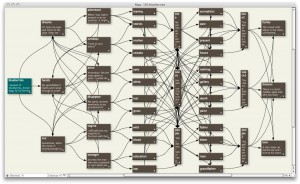Just started a story with an idea, a man walking in the night through the woods. Taking pause as that scene settles, I think about other things, yet never too far away that I cannot hear him if he calls.
What I’m thinking about is this: What set the form of story?
Working and switching among straight text, hypertext in Storyspace and hypertext in Hypertextopia, it surprises me that I already know this story is meant for traditional linear telling. It has no need for the roundabouts or playing with time of Storyspace mapping. It does not call for the Shards of clarity from Hypertextopia. At least not at this point. The man is alone, the night is rumbling.
Is the situation what settles the form? What calls out the innuendos and acuteness of side trails? It certainly can’t be the loneness of the character, as in A Bottle of Beer, Yolanda sits alone on her porch awaiting a man running down the road towards her throughout the story. Ah, but she is surrounded by ghosts; from her past, from human nature, and from instinct. There is a natural pattern that develops that is asking these ghosts to drift through the story. The intricacy of Storyspace’s trails would be overkill; we don’t want the reader to wander away from the immediacy of Yolanda’s last hour–which is the whole of the story. Hypertextopia is then perfect for that particular piece. Paths was begging for parallel paths (uh, hence, it’s title) and needed the coexistence of threads that separated yet tied lives together. Neither story could likely have been told in a different form with any degree of accuracy–of sense of exactly how it happened.
So it is not the singleness of character, the singleness of purpose–and perhaps if the focus of this man’s story was different it would indeed call out for an exploration via links. What then?
I don’t truly know.
 So it’s sort of done; about 44 writing spaces and 153 links. While I was surprised to see what all the linking back did to the story–it makes it appear as if you’ve read it all but if you click on a ‘visited’ link you’ll usually find that you haven’t followed many off that next space. There are three different endings and God only knows how many different ways of getting there.
So it’s sort of done; about 44 writing spaces and 153 links. While I was surprised to see what all the linking back did to the story–it makes it appear as if you’ve read it all but if you click on a ‘visited’ link you’ll usually find that you haven’t followed many off that next space. There are three different endings and God only knows how many different ways of getting there.
 The Lost Children: A Charity Anthology
The Lost Children: A Charity Anthology